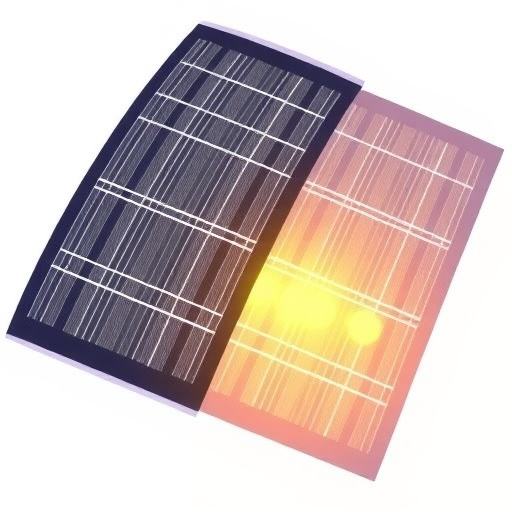Dye-sensitized solar cells (DSSCs) have emerged as a promising alternative to traditional silicon-based solar technologies. Their unique operational principles and lower production costs have garnered significant interest worldwide. In recent years, extensive research has focused on the optimization of the materials used in DSSCs, leading to remarkable advancements. The work presented by Dahri et al. highlights significant breakthroughs in flexible counter electrodes, which play a critical role in the overall efficiency and functionality of these solar cells.
The flexible nature of these solar cells is a game-changer. The traditional rigid panels are often limited in their applications due to their weight and fragility. In contrast, flexible DSSCs can be applied to a variety of surfaces, including textiles, curved structures, and even wearable technologies. This adaptability opens up a multitude of possibilities not only for generating energy in unconventional settings but also for enhancing the aesthetic value of energy generation systems.
Material advancements have been pivotal in enhancing the performance of flexible counter electrodes. These components are vital for facilitating the necessary electrochemical reactions that occur within the solar cell. The selection of materials that can effectively serve as conductive substrates while maintaining flexibility is crucial. Research has diversified into various materials, including carbon-based nanomaterials, conducting polymers, and new metallic compounds, all of which have their unique advantages and challenges.
Among the wide range of materials explored, carbon nanotubes and graphene derivatives stand out for their exceptional electrical conductivity and mechanical properties. Leveraging these materials in the construction of counter electrodes enhances electron transport while ensuring durability under bending and stretching conditions. This is particularly relevant for applications that require the solar panels to be installed on dynamic surfaces or in wearable gadgets where flexibility is non-negotiable.
Another material that has gained traction in recent studies is conducting polymers. These organic materials provide inherent flexibility and can be easily processed into thin films. Their use in flexible counter electrodes allows for a substantial reduction in weight, making them ideal candidates for applications in lightweight solar technology. Furthermore, conducting polymers can be engineered at the molecular level to tailor their properties according to specific requirements, driving innovations in photoelectrochemical cells.
Metallic compounds such as silver and gold have also been investigated for their potential. Although heavier than their carbon counterparts, certain metal nanostructures can substantially improve conductivity and enhance light absorption due to their plasmonic properties. Incorporating these materials into hybrid designs can yield innovative solutions that combine the benefits of both metal and carbon-based systems.
One of the critical challenges remaining in the field of flexible DSSCs is ensuring long-term stability under varying environmental conditions. Investigating degradation mechanisms in flexible electrodes is paramount to enhance their lifetimes. This includes understanding the interaction between the electrolyte and the electrode materials in flexible configurations, as well as how these interactions affect the electrochemical stability over time. Ongoing research aims to identify optimal combinations and protective coatings that can trap moisture and prevent exposure to oxygen, which are primary contributors to material degradation.
The application of advanced manufacturing techniques plays a considerable part in evolving the fabrication methods of flexible DSSCs. Techniques such as roll-to-roll printing and inkjet printing are becoming more mainstream, enabling scalable production of these cells. These methods facilitate more uniform and precise material application, significantly reducing manufacturing costs and enabling mass-market adoption of flexible solar technologies.
Moreover, the integration of flexible DSSCs in building-integrated photovoltaics (BIPV) represents another pillar of sustainability in modern architecture. Incorporating solar cells within building materials makes it possible to harness solar energy without compromising aesthetic appeal. The advancement of flexible counter electrode materials simplifies the integration of solar technologies into new construction projects, allowing architectural designs to marry functionality with sustainability seamlessly.
As the demand for renewable energy increases, so does the pressure to enhance the efficiency of solar technologies. The comparative advantages offered by flexible DSSCs, such as their lightweight design and aesthetically pleasing formats, position them competitively within the renewable energy landscape. Significant investments in research and development are anticipated in the coming years to increase the efficiency rates and lower the production costs of these innovative energy solutions.
Public perception and awareness surrounding solar power technologies are also shifting. As consumers become more environmentally conscious and seek sustainable energy alternatives, flexible DSSCs are poised to gain traction. The community and educational outreach initiatives focusing on the advantages of solar energy usage can play a crucial role in amplifying interest in these innovative technologies.
The review by Dahri and colleagues provides a crucial roadmap for future research directions. By detailing the advancements in flexible counter electrodes, the authors underscore the importance of interdisciplinary approaches combining materials science, engineering, and environmental studies. This comprehensive approach is essential for realizing the full potential of flexible DSSCs as a transformative technology in the renewable energy sector.
Ultimately, the advancements highlighted in this comprehensive review are set to facilitate a transition toward more sustainable energy solutions, offering promise not only for the research community but also for policy-makers and energy consumers alike. As we continue to pursue innovative solutions to meet rising energy demands, flexible solar technologies resound with the potential to shift paradigms in energy generation.
The journey of enhancing flexible counter electrodes in dye-sensitized solar cells extends beyond mere scientific inquiry; it embodies the collective aspiration for a sustainable future powered by renewable energy. With ongoing studies and innovations in material advancements, the vision of a cleaner, greener planet appears ever more within reach.
Subject of Research: Research on advancements in flexible counter electrodes for dye-sensitized solar cells.
Article Title: A comprehensive review of material advancement in flexible counter electrodes for dye-sensitized solar cells.
Article References:
Dahri, A.B., Memon, A., Mengal, N. et al. A comprehensive review of material advancement in flexible counter electrodes for dye-sensitized solar cells.
Ionics (2025). https://doi.org/10.1007/s11581-025-06747-7
Image Credits: AI Generated
DOI: https://doi.org/10.1007/s11581-025-06747-7
Keywords: flexible counter electrodes, dye-sensitized solar cells, material advancement, renewable energy, conducting polymers, carbon-based materials, manufacturing techniques.




